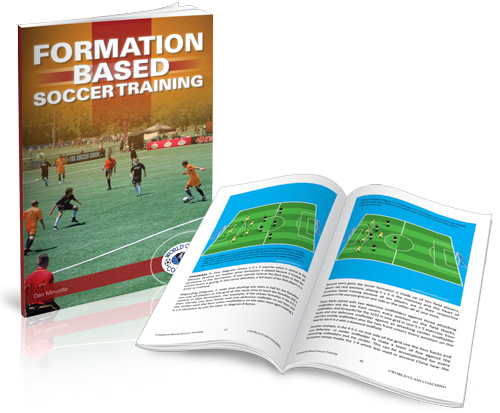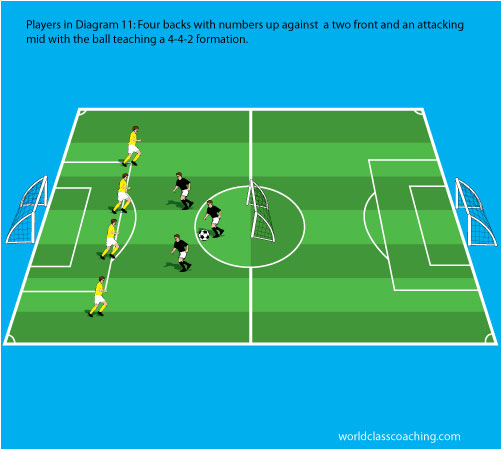Small-sided games are a great tool for player development. But as with any tool they must be used correctly to achieve the best results. It's not enough to create two teams of eight and drop a ball. The more specifically you design the game, the more your players will benefit.
Most coaches will choose a game that focuses on the technical or tactical elements that were worked on earlier in the session but many miss the one factor that can be the difference between a session that translates into improved performance in the next match: the formation that the teams use during the small-sided game.
Playing small-sided games in the same formation that your team uses on game day means that the players will get used to the shape and angles of support of your formation and know more about what to expect from their teammates and the opponents.
Here's an excerpt from, 'Formation Based Soccer Training', that talks about this in more detail.
3 v 4 EXERCISES TO TRAIN THE 4-4-2 DIAMOND MIDFIELD, FLAT BACK, ZONAL DEFENDING
OBJECTIVE: HOLDING THE FLAT BACK SHAPE IN THE BACK, TRAINING ZONAL DEFENDING
Players and equipment: 7 players; square shaped grid large enough to play 3 v 4 to small, Pugg type nets; seven bibs, three one color and four a different color; two Pugg nets placed opposite each other at each end line.
Objective: To force the four players on one team (backs) when defending to stay compact playing flat and defending zonally; and to force the three players on the other team when playing offense to move the ball wide with centered balls to the vital area to create shots on goal. This exercise is for the benefit of the defending players. Use four backs on one side. The other side should be the one attacking mid at the top of the diamond shaped midfield and the two front or the two outside midfielders and the one defensive mid at the bottom of the diamond. Remember, this is only a sample objective. The objective changes each time a training session theme changes but positional play remains the same.
Set up: Square shaped grid with small, Pugg type nets placed opposite each other at each end line large enough to play 3 v 4, two-way directional (about 40x40 yards). Two teams of three players on one team and four backs on the other team in different colored bibs playing against each other, no limit on touches. Place 3 soccer balls in each Pugg type net to be used to keep the game going after a shot on goal.
Exercise: Two teams in bibs, two-way directional competition to score to goal. Unlimited touches. Defending team must maintain flat shape. First team to reach three goals wins. Use multiple grids so all players are involved at one time.
Progression: From Pugg type nets to target players: Remove Pugg type nets and replace with a target player without a bib at each end line. The target player moves in the goal channel, behind the end line to stay open to collect a ball shot to him. The target player belongs to the team on his side of the grid. Rather than shooting to the Pugg type nets, each team now shoots or passes to the target on the opposite team who collects the ball and passes it back to a player on his team (the opposite team that passed the ball to him) to start play again. The pass made by the target player must be done quickly to keep the game moving.
To small cone goals: Leave the target player as is and add a cone about two yards to his right and another cone about two yards to his left creating a small goal area. The target player can move laterally within this small goal area to collect the ball. The purpose of this small goal is to give perspective to the shooter with an obstruction (the target) in goal. The shooter is to try to avoid the target rather than pass to the target as in the earlier progression. The target which could be a keeper using his hands or a field player not allowed to use his hands, tries to stop the shot on goal. He collects the ball and distributes to his team.
To full sized goals with no keeper: Replace the target and small cone goals with a full sized goal with no keeper. The full sized goals are at each end line.
To full sized goals with keepers: Add a keeper in each goal.
The square shaped grid marked with cones or disks remains the same for each of these 3 v 4 exercises.
Or, use four backs, flat, and two outside midfielders with a defensive mid at the bottom of triangle.
Next, restrict touches for the 3 attacking players to two touch.
Have a Great Day!
Tom




